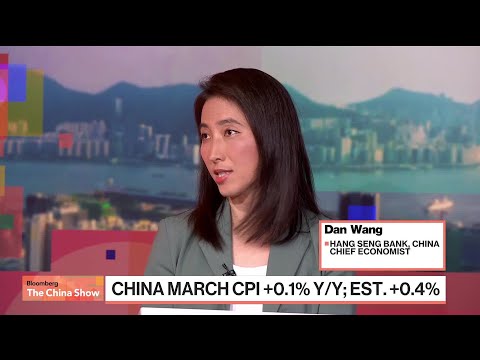
China Likely to Be Stuck in Low Inflation Environment: Hang Seng Bank
4.9 forecast for my next guest. Ed Wong is with us here on set, chief economist at Hang Seng Bank, China, 4.9% upside risks to that figure. Well, it’s hard to be too optimistic at this point, especially with the ugly data coming out for quarter one. And the 4.9
is towards the lower end of the government’s target range. And we think there’s a chance that we might have to lower this forecast, given how difficult it is for a lot of projects to roll out in China right now. Where is the deflate, the inflation right now, I
should say, without inflation print? It seems like we’re still not seeing any signs of domestic demand coming back in a big way. Yeah, if we’re talking about goods market, there’s really no sign of any prices going up. Maybe from the second quarter on, the poor price might pick
up because the supply demand is starting to shift on The supply of the pigs are starting to decline from earlier this year. And then when it comes to the services prices of tourism, transportation, entertainment, they do have a tendency to go up in the first quarter, especially we
have a longer holiday season, this time in April, and that has encouraged a lot of people to get out and spend more money. And slightly, we see
I’m wondering what the mindset of consumers are as it pertains to inflation. Is it are people thinking prices are going to fall because that’s a bad mindset to get into for consumers? Well, if you’re living in China, people have this perception now that inflation is a is is
nowhere to be found. Probably it’s going to be a permanent phenomenon that China will be stuck in this sort of low inflation environment. And a big reason for that is when you look at different industries, there is do a trade war going on. Know almost all the consumer
goods sector and the factory inflation has been going down down for over a year now. For Chinese companies, they are under huge pressure to actually adjusting down their prices instead of adjusting up. And for Chinese consumers, they’re still quite conservative about where the economy is going with the
housing market down. And people actually still have very high tendency to save up more. So that brings me to this overall overcapacity conversation that’s taking place. Janet Yellen was in was in China recently. And is there an overcapacity in in Chinese industry right now? From an economic perspective,
you have to define overcapacity because the inflation is that inflation. Exactly. So other price, you can basically sell anything. But before COVID started, China was going through this phase of overinvestment in the manufacturing industry. So it is true that across the board, it’s not just only within those
green industries like the emerging industries, new energy, new material, but also in traditional industries like cement or glass, you name it. Almost every single industrial sector is going through this overinvestment and now we see a lot of capacity. Part of it was because there is a lack of
demand for housing and construction. But the other part is really coming from this huge effort from the government to help China to gain more advantage in its green technology and a growing industry. So as a result, we do see this lack of lack of momentum in the industry
to curb back its its investment in those industries. But I think the bottleneck still is in the demand side. So if the global market is still open to China, then we won’t have a long term overcapacity problem. But now I just think that not just Americans, but also
the Europeans start to be very concerned that China’s cheap products, including the green products, will wipe out some of their industry.
